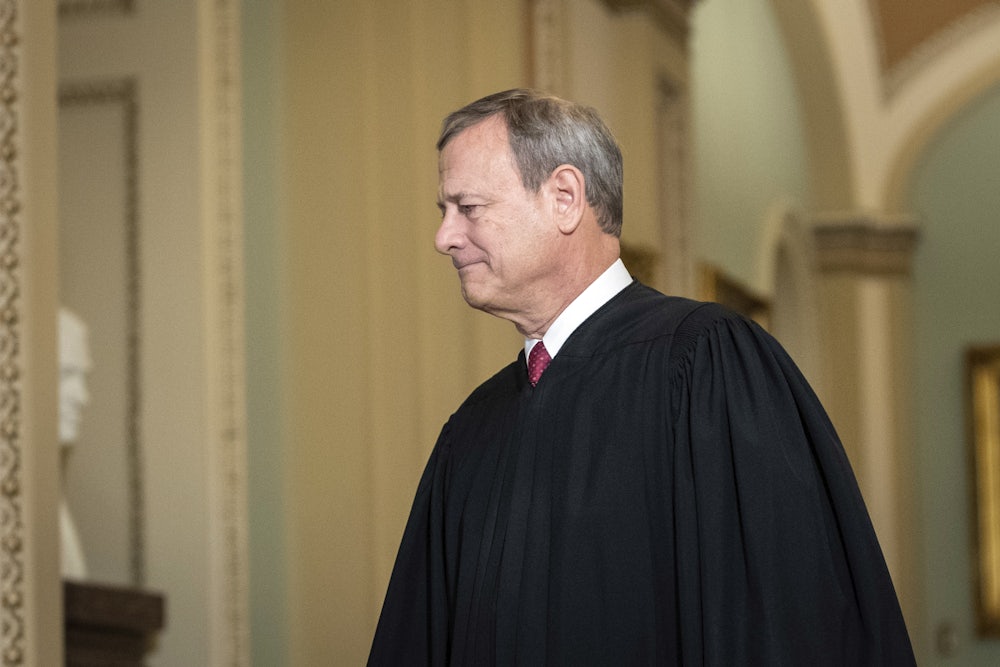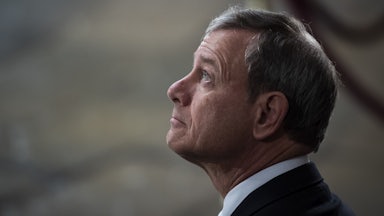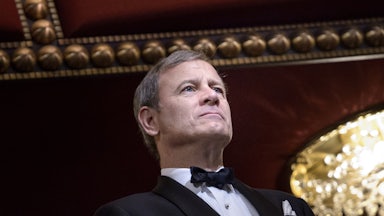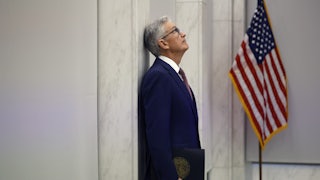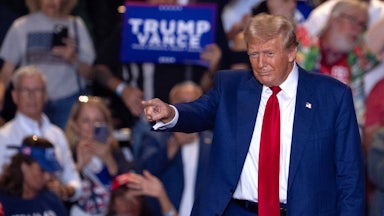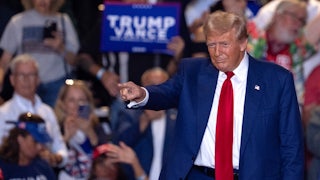Most Americans escaped the clutches of 2021 with a mixture of exhaustion and relief. The Supreme Court, for its part, closed out the year with two quiet but notable moves. One of them came in the sprawling litigation over the Biden administration’s Covid-testing mandate. The other occurred in Chief Justice John Roberts’s annual year-end report on the federal judiciary. Though not obviously related, they both say something about how the high court is navigating criticism and calls for reform.
First, on the testing-mandate cases. The Occupational Safety and Health Administration released an emergency rule last fall to require most employers with more than 100 workers to test their unvaccinated employees regularly. A variety of businesses and conservative legal groups sued the agency in their nearest federal court, arguing that the mandate was illegal, unconstitutional, or both. Those cases were consolidated and randomly assigned to the Sixth Circuit Court of Appeals, but not before the Fifth Circuit had issued a stay blocking OSHA from enforcing the testing mandate. On December 17, the Sixth Circuit formally dissolved that stay, kicking off a race among the plaintiffs to file an appeal to the Supreme Court.
This is a familiar pattern for anyone who’s followed American politics in recent years. It’s no longer unusual for an administration’s political opponents—whether they be Democrats or Republicans—to challenge every major agency rule or action with which they disagree in federal court. Sometimes the plaintiffs don’t even need to win on the merits to win. The relatively glacial pace of the federal courts means that a judge’s decision on whether to block a policy’s enforcement while litigation unfolds could end up proving fatal if the White House changes hands, as it did for the Obama administration’s Clean Power Plan or the Trump administration’s public charge rule. In the case of the testing-mandate cases, where the legal battle is unlikely to outlast the Biden administration, even delaying a policy can be a victory all on its own for a president’s political foes.
When you think of the average Supreme Court case, you’re probably calling to mind a case that reaches the justices through the court’s regular appeals docket. Those cases have oral arguments and written opinions and publicly recorded votes and all the other trappings of judicial authority that Americans have come to expect from the nine robed figures who shape their lives. A motion for an emergency stay (or a motion to lift an emergency stay, for that matter) is not one of those cases. It is instead funneled through the court’s processes for emergency motions, a cloudy process better known today as the “shadow docket.” In that penumbral realm, the justices are not obligated to explain their thinking or to say how they voted when deciding even the most consequential of matters.
This arrangement may be changing. On December 22, five days after the Sixth Circuit ruling, the Supreme Court announced that it was going to do something weird. It “deferred” a decision on the stay requests for the testing mandate “pending oral argument.” And in a show of haste that probably upended more than a few lawyers’ holiday plans, it scheduled those arguments to take place on January 7. This is a sharp break with the court’s modern practices. Until the 1980s, the individual justices would occasionally get some kind of oral briefing when handling an emergency stay request from their assigned circuit. But the nine justices collectively haven’t heard oral arguments for one of them since at least 1970.
Why the abrupt change? None of the parties requested it in their filings for the court. It’s possible that the justices thought there was something extraordinary or unusual about the dispute over OSHA’s testing mandate itself. But no shortage of high-stakes and high-profile cases have reached the Supreme Court’s shadow docket in recent years, and it’s unclear why this one would warrant special treatment on its own merits. In other major shadow-docket cases this term, such as the showdown over Texas’s abortion-bounty law or one involving a religious freedom claim by a death-row prisoner, the court resolved the stay request first and then fast-tracked it for full consideration on the underlying issue.
The answer may lie with recent criticism of the shadow docket itself. While the justices have had a process for handling emergency and administrative motions of some kind since the dawn of the republic, it only began to receive academic and journalistic scrutiny in the last few years. The “shadow docket” is described as such not because it is necessarily sinister but because it is frustratingly opaque. William Baude, a University of Chicago law professor, coined the term in a 2015 law review article where he argued the court’s actions “seem to deviate from its otherwise high standards of transparency and legal craft” found in its regular docket. “It would be far too hasty to say that the orders decisions are thoughtless or the result of unjustified inconsistency,” Baude argued. “But the Court could do more to reassure us that they are not.”
Since the shadow docket is also a forum in which high-profile disputes are increasingly resolved, its shortcomings have also increasingly drawn scrutiny from Congress, the public, and the court’s own members. In September, the Senate Judiciary Committee held a hearing on the court’s shadow-docket decision not to block Texas’s abortion-bounty law, which effectively led to the suspension of Roe v. Wade in that state, and explored possible steps that lawmakers could take to fix it. Justice Elena Kagan, writing in dissent in that case, argued that the majority’s actions were “emblematic of too much of this Court’s shadow-docket decision-making—which every day becomes more unreasoned, inconsistent, and impossible to defend.”
Does the Supreme Court’s sudden adoption of oral arguments for this stay application, and perhaps other high-profile ones down the road, mean that the court is proactively responding to calls for reform? That also happened to be the theme of Chief Justice John Roberts’s year-end report on the federal judiciary, which he released on December 31. The annual report is supposed to be a compilation of statistics about the courts and their caseload each year. As you might imagine, it is not a particularly thrilling read.
But it is also one of the few instances where Roberts says much of anything in public, outside of written opinions or oral arguments. The chief justice keeps a fairly low profile, even by the court’s standards. Unlike the other eight justices, he does not regularly speak at law schools or take part in events held by legal organizations. He is among the minority of his colleagues who haven’t written a book while on the court. I am not aware of a single interview of any kind that Roberts has done since his confirmation hearing in 2005. When he replied to the Associated Press’s routine request for comment about former President Donald Trump’s attack on “Obama judges” in 2018, his two-sentence rebuke drew headlines across the country and a half-backtrack from Trump himself.
When Roberts says anything in public, in other words, it’s typically worth paying attention—especially since the chief justice often resorts to layered anecdotes from legal history to make his point. In his 2018 report, he opened with a story about the importance of law clerks in the outcome of a landmark Fourth Amendment case and went on to describe how the judiciary would be responding to reports of workplace misconduct by federal judges. His 2020 report, which focused on the courts’ administrative response to the pandemic, recounted how the early Supreme Court’s work was disrupted by yellow fever epidemics. And while it might have been a coincidence, I couldn’t help but notice at the time that Roberts’s 2016 report, which praised the thankless work of federal district court judges, came after the then president-elect had launched a series of racist attacks on one of them that year.
This year’s history lesson was about William Howard Taft, who had the unequaled distinction of serving as both president and chief justice in the early twentieth century. Taft is remembered today less for his legal philosophy and more for his acumen in securing reforms from Congress that strengthened the court. “Chief Justice Taft was prescient in recognizing the need for the Judiciary to manage its internal affairs, both to promote informed administration and to ensure independence of the Branch,” Roberts wrote. “He understood that criticism of the courts is inevitable, and he lived through an era when federal courts faced strident calls for reform, some warranted and some not.”
Roberts’s comment on “strident calls for reform” is probably not accidental. There is more public debate about major Supreme Court reforms today than in the last 50 years, mostly revolving around calls for court-packing by some Democrats and liberals. “Decisional independence is essential to due process, promoting impartial decision-making, free from political or other extraneous influence,” Roberts explained. “But Taft recognized that courts also require ample institutional independence. The judiciary’s power to manage its internal affairs insulates courts from inappropriate political influence and is crucial to preserving public trust in its work as a separate and coequal branch of government.”
One of Taft’s accomplishments was persuading Congress to create a permanent policymaking body for the federal courts, led by the chief justice and a rotating selection of federal judges from across the country. Roberts highlighted the Judicial Conference’s work in responding to a few major issues, including judicial misconduct in the workplace and a series of Wall Street Journal reports on lax recusal practices by federal judges with financial conflicts of interest. But the overall thrust of his remarks is something akin to a Roberts Doctrine: If anyone is going to reform the courts, it must be the courts themselves.
To those outside the judiciary, it’s hard to read his remarks as anything but an implicit push back against court-packing and other partisan-driven changes. But it can also be read as a warning of sorts for those inside the judiciary, as well. Roberts is no longer the court’s median vote and thus cannot shape the court’s decisions and outcomes as he once did to shore up its institutional credibility. But perhaps he and his colleagues can figure out a way to do so collaboratively. After all, if the court proves to be incapable of reforming itself, then someone else will inevitably step in and force reform upon it.
